One Legged Squat (The Pistol)
The one legged squat is a great test of both leg strength and balance. In this tutorial, I’ll show you several methods I’ve used to teach myself and others the skill.
Form
You’ll start the pistol standing on one leg, squat down to the position pictured below, then press back up with just that single leg.
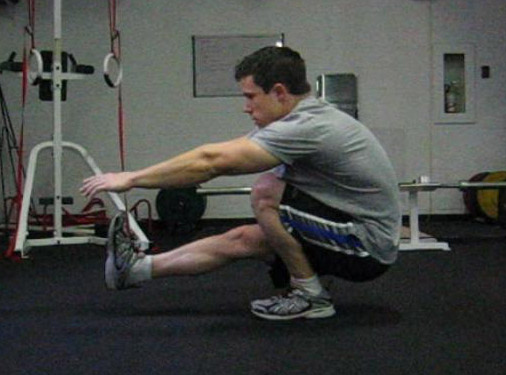
You’ll notice that my base foot is flat on the ground – don’t rock up on your toes, as that’s a great way to twist and injury your knee. The shin is leaning forward with the knee over the toes. This will help keep your weight forward and the skill balanced. Also note that the hamstring and calf of the pressing leg are touching. This will let you know when you are at the bottom of the squat. You’ll find that you can “sit back” slightly once at the bottom, but the degree at which you can do this is dictated by femur length, so just look to touch the hamstring and calf and you’ll be fine.
The next thing to notice is my torso. It is leaning forward, close to my pressing leg so that my weight is forward and I can stay balanced. You’ll need to focus on compressing your body towards your pressing leg so that you can keep this position. If you let the torso lean back too far, you’ll usually end up falling to your back.
Extending the arms forward helps to keep weight balanced, as well as providing some lateral stability. With the foot being the only point of contact with the ground, we need to balance our weight over it. See where my hips and torso are? Behind my foot. So you better believe I’m going to stretch my arms and leg out to get some weight forward of my foot.
When you start your descent to the ground, start with the position shown below. The arms are held out in front and the free leg is held out straight in front of you. I tell people that they should imagine the leg is straight like it’s stuck in a ski cast. You don’t have to lift it to hip level, just high enough so that it doesn’t hit the ground. My hamstring flexibility could use some improvement, so my leg bends slightly at the bottom, but it still stays off the ground! More on flexibility in the next section.
.jpg)

If you do have problems keeping the free leg straight or lifting it high enough when you are at the bottom, a good drill is to simply stand up on two feet and then lift one leg straight out in front of you and hold it. This feels remarkably similar to how the free leg will feel at the bottom of a pistol.
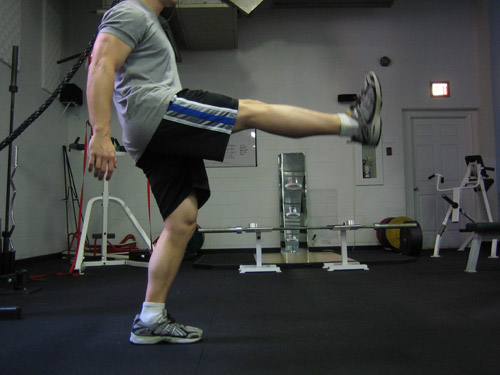
Tips
– I tend to think about pushing the knee forward in order to initiate the squat. This seems to keep my weight over my foot. If my weight is slightly forward as I reach the bottom, then I just shift my weight backwards slightly and sit back into the bottom position. If I drop my hips back without making sure my knee goes forward, then my weight tends to be too far back and I’ll fall backwards. Pulling the weight forward with just the strength of the shin (the tibialis anterior) at the bottom is much harder than simply sitting back into position.
– You need to keep two areas of the body compressed as much as possible – your abdomen to the top of your thigh, and your shin to the top of your foot. If either one opens up too much, it’ll shift too much bodyweight backwards and put you on your butt.
– On a similar note, keep everything tight! Losing tension oftentimes means losing balance.
– Don’t drop into the skill! Control it! Not only can you hurt the knee by dropping into the bottom too fast, but you tend to lose any sort of muscular tension in the leg which makes it harder to press up.
– For the free leg, flex the quad hard to keep it off the ground and resist the temptation and natural inclination to put it on the ground and assist the squat.
– Knee pain is often a sign of improper technique (assuming no previous abnormalities exist). Take a step back and try an easier exercise, in addition to rereading the points I’ve made of controlling the skill and not bouncing out of the bottom.
Flexibility
Mobility in the hips and legs is vital to getting this skill. Tightness in the muscles will prevent you from squatting all the way to the bottom, as well as make it harder (or impossible) to keep yourself tucked in tight to maintain balance.
I’ve found that tightness in the calves, ankles, and hamstrings to be particularly problematic. Tight calves and ankles tend to make it difficult for the lower leg and knee to shift forward as you squat down. Tight hamstrings make it difficult to straighten out the free leg at the bottom of the squat.
I won’t get into specific stretches here, as there has already been plenty written on the subject, but I will recommend the book “Relax into Stretch” by Pavel Tsatsouline. It describes plenty of useful stretches, as well as methods to stretch smarter for greater flexibility. My flexibility is less than ideal and I’ve been using the book’s stretches and methods to correct that.
Here is an article on Full Squat Flexibility which further discusses and elaborates on some flexibility issues with the basic squat.
Progressions
Feel free to use one or more of these exercises based on your ability, liking, and available equipment.
Method One – Squats!
Weighted squats are an incredible exercise, and going nice and low with them helps build some incredible strength in your legs. This ended up being the only method I used. Seriously, the only one. I had worked rock bottom squats for several months before I had even heard of the pistol, but I was able to pick up the skill very quickly and easily because I had developed strength in the necessary range of motion.
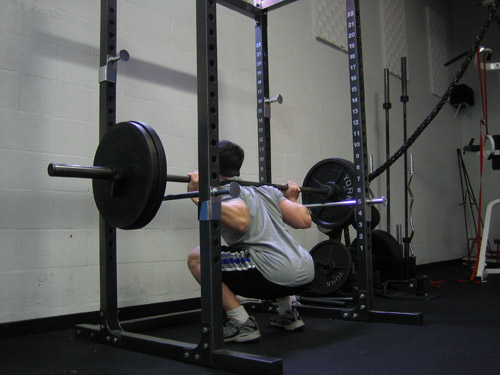
Make sure you find someone knowledgeable to teach you how to squat if you do not know already. I won’t go into detail here, as there is plenty already written about the exercise, but make sure your form is good to prevent injury. Even if you’ve been squatting for awhile, it never hurts to review your form. I recently found out that my pelvis posteriorly tilts at the bottom of my squats due to my inflexibility. You better believe I’m working to correct it and prevent a back injury!
A search will also turn up many articles on the squat and proper form, although let me recommend again this article on Full Squat Flexibility.
Method Two – Modified Single Leg Step-ups
This next exercise may look familiar, but it has subtle variations that make it much harder and more effective.
Now most people have probably done some sort of leg exercise where they stepped up onto a box or bench. In the very least most of us have walked up a flight of steps! In this exercise we are going to try and take away any and all assistance that the lower leg provides. This will essentially force the body into a one legged squat.
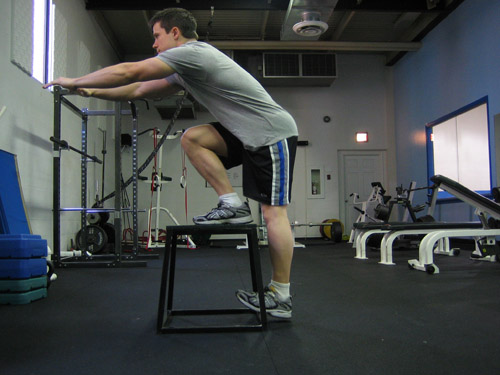
First thing to notice is that my bodyweight is shifted forward over the top leg. This is to help ensure that I press only with that leg. The second and most important feature of this exercise to take note of is my bottom foot.
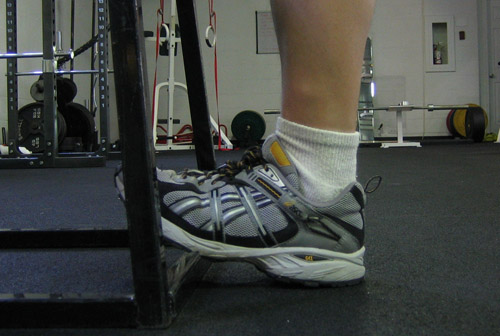
I am dorsiflexing the foot, which is just a fancy way of saying that I’m lifting up and holding my toes at the start of the exercise. In a regular step-up, you would instinctually press the ball of this foot into the ground as you flex your calf and ankle to help lift your body up. By lifting up the toe and keeping them off the ground, the calf can no longer help lift you up.
You still need to be careful not to flex and extend your knee when stepping up. This will assist your other leg and reduce the effectiveness of the exercise. So keep your toes up and concentrate on not moving that bottom leg at all. There should be absolutely no movement in the bottom leg. None. Zero. Nada.
This exercise is difficult for two reason, first is that when done correctly the top pressing leg is essentially doing a one legged squat from the bottom up. The second difficulty is overcoming your natural reaction to use that bottom leg. Again, don’t flex at the ankle or knee! Only press with the top leg! If this exercise is easy the first time you do it, and you can’t do a pistol yet, then you may very well be doing it wrong!
Obviously you can increase or decrease the height of the step to make the exercise easier or harder. If you don’t have an open box like I have in the picture, then stand so that your free leg is to one side or another of the box.
Weighting the exercise down is also an option and in my opinion, more comfortable than trying to weight down a pistol. More on that point at the end.
Method Three – Increasing Range of Motion
This is probably the most intuitive method for getting this skill. With this method, we’ll squat down to a step, box, or bench. As our strength increases, we’ll simply find a lower box. Keep on trying to lower the step until you’ve got yourself a full range pistol. Keep in mind though that a small increase in the range can make things significantly harder.
In the pictures below I use a plyometric box, as I have several in my gym of varying heights. You could use a chair, footstool, or even stand at the base of a flight of steps. Whatever you do pick to squat down to, make sure that it would survive if you fell on top of it. I guarantee there will be times when you can’t push the squat back up. Falling butt first into something that crumples, shatters, breaks, or explodes underneath you isn’t much fun. Only for those who get to watch.
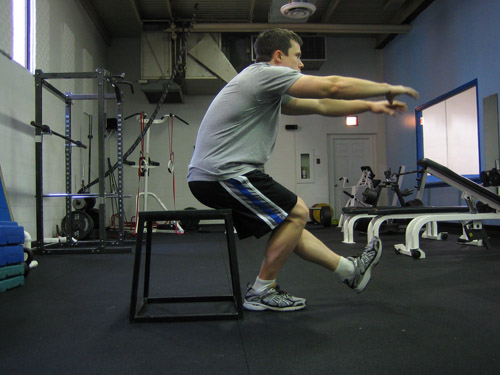
Now it’s important NOT to sit back onto the box. Keep your balance over your foot. You are simply using the box as a way to measure your squat depth. If you sit back onto the box, you’re only teaching yourself how to shift your weight backwards and off balance.
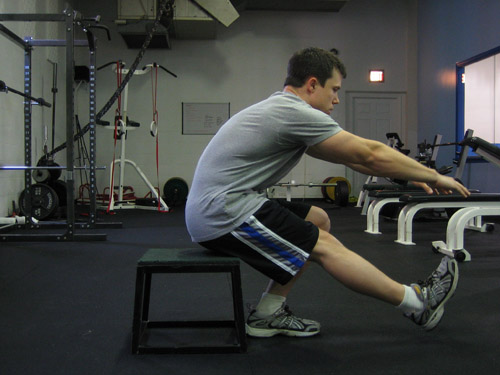
You should try to touch the box lightly with your butt and then come right back up. This will keep tension in your leg for the entire exercise, just like a full pistol.
Now you don’t need 20 different boxes of varying heights. Each box you use can have anywhere from 6-8 inches (15 -20 cm) height difference. To make transition from one box to another easier, you can also put down a book or thin box or any number of things that are about half as tall as the height difference between the two boxes. Again, make sure it’ll survive if you fall butt first into it.
Method Four – Assisted Full Range
With this method, we’ll squat the full range of motion for the pistol, but use various means of assistance to help us. In addition to working the full range of motion, you can also stop at any point along there and try to hold it or move back and forth in a short range of motion. I’ve found this is a good way of getting rid of sticking points.
Doorway
This is one of the easiest and most accessible ways to add some assistance to a one legged squat. Simply face sideways in a doorway and grab the door frame. Now squat down and up while using the frame to keep you in proper form.

Make sure yon’t get sloppy with your technique. Keep your free leg straight and the heel of your pressing leg on the ground. Also make sure that you keep the knee of the pressing leg forward. It’s easy to grab onto the frame and lean back too far.
You can try lowering to the bottom of the pistol, then letting your hands go off the doorframe. You’ll find quick whether you’re in proper balance or not.
Bands
Bands are a great way to help assist the pistol because they move and sway more than a doorway (pick some up here!). Now if you don’t conveniently have bands attached to a brick wall, then it’s time to improvise with bicycling tubing on a doorknob or some other such homemade set-up. Even using something that doesn’t stretch well can still be beneficial because of the added lateral instability.
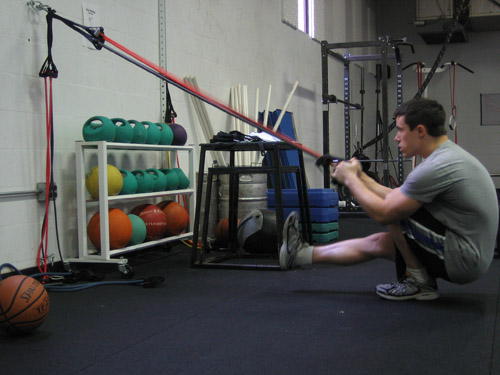
It’s important to use the bands correctly. You need to keep your body nice and tight to maintain form, while using only your arms to pull or slacken the bands. If you start leaning back like you’re waterskiing in order to get more tension in the bands, then you’ll just be enforcing bad habits that’ll carryover to the unassisted pistol.
Counter-weight
This is a great assistance method if your legs feel strong enough, but you have a bit of a problem keeping everything tight and compressed. It sounds counter-intuitive that adding weight would make the exercise easier, but a few extra pounds held out in front of your center of balance can help things tremendously.

I like to hold the weight at arms’ length so that it will go in front of the knee of the squatting leg when I’m down at the bottom.
Now to progress with this method, simply reduce the amount of weight you hold until there’s nothing left.
Method Five – Deck Pistols
This variation starts like a normal pistol, but at the bottom you want to roll backwards off your heel and onto your upper back, then roll forward again onto your heel and press up from the bottom. Rolling forward will give you some momentum in pressing out of the bottom position.
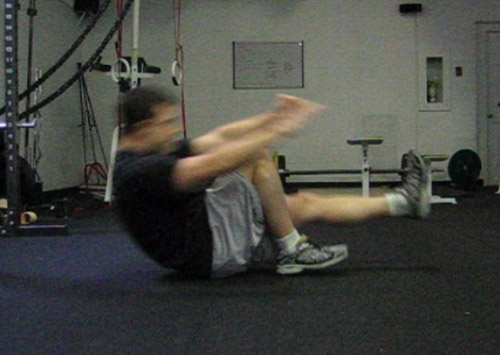
You can start off by rocking down, back, and up with two legs. Next, try rocking down and back with two legs but up with one. And finally, rock down, back, and up with only one leg. This will allow you to work the full range of motion, but have some momentum to help you up.
Training Program
There are various ways to train for this skill. Some may find working the skill frequently for a small amount of repetitions to work (grease the groove method). If you add it to your workout as your leg exercise, I’ve found that doing singles back and forth between legs to work well in the beginning. It’ll allow one leg to rest briefly as the other leg is pressing. Add more consecutive repetitions for each leg as you get stronger.
I recommend working it until your form starts to suffer. At this point you could switch from one exercise to an easier exercise, full pistol to doorway assisted pistol for example, in order to get more work done for the legs.
The Next Level
Learning the pistol is just the first step. There are several additional exercises you can try for variety and challenge.
Bottoms up pistols
In this variation, you’ll squat to the ground with two legs, then extend one leg out in front and proceed with a normal pistol. Starting from the bottom forces you to create the maximal amount of tension straight from the beginning. Sorry, no picture with this one as I hope the explanation is enough!
Jumping pistols
When you get the pistol down proficiently, you can try squatting down then jumping for distance or height.
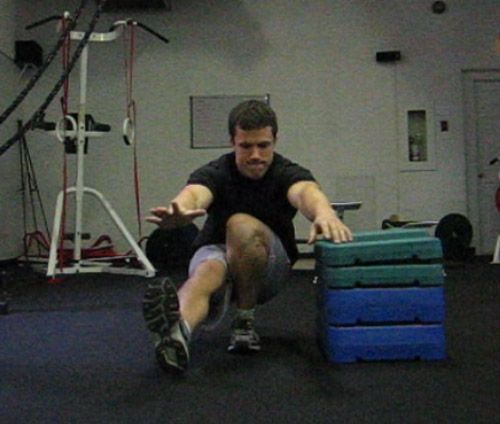 |
Jumping up from the skill isn’t nearly as hard as you might think. It essentially becomes a one legged hop when you get to the top of the movement. In addition, you can use your arms to assist in the jump. | |
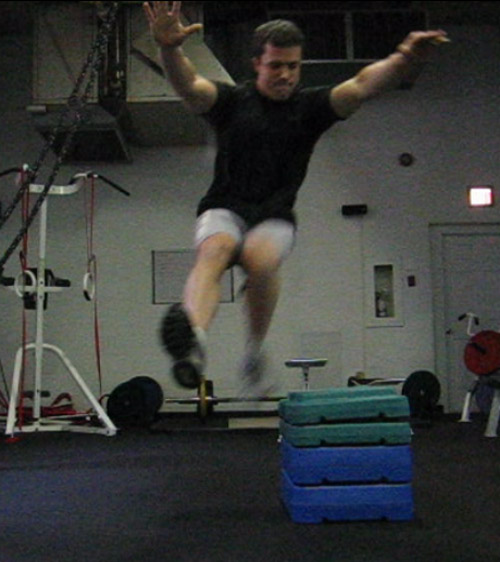 |
I would recommend jumping sideways onto any box if you’re going for height. Jumping forward and backward onto a box has too much risk for injury, especially as you fatigue. | |
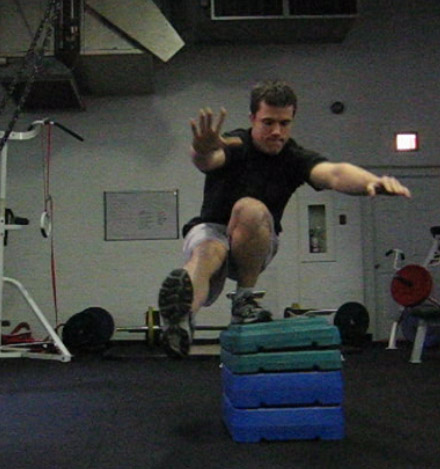 |
Make sure to absorb the landing, just like a regular jump, whether you’re landing up on the box or back down to the ground. |
Weighted pistols
Weighting down the pistol can be done in a variety of ways. You could rack a pair of dumbbells or kettlebells up by your shoulders, or hold a single heavy weight out in front of you. You can cross your arms and put a bar across the tops of your shoulders like a front squat. I’ve found all to be suitable for adding weight to a pistol.
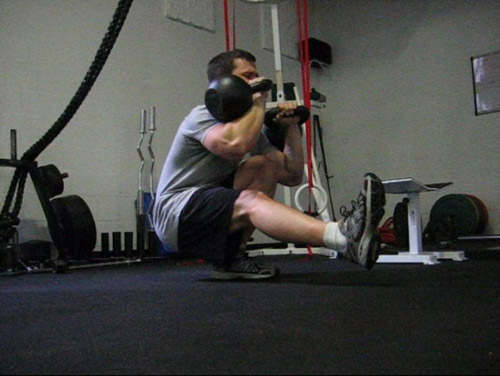
I mentioned earlier that I felt weighting down the modified single leg step-ups to be more comfortable. It gives all the benefits of a weighted pistol, but puts the back in a safer position and is safer if you have to bail out. Personally speaking, I don’t train weighted pistols at all and prefer the modified step-up for any heavy single leg work.
I hope I’ve given you some training ideas for working up to a one legged squat, as well as challenges to further strengthen the skill. The pistol often looks easy at first glance, but it’ll soon show you if you have any weakness in your legs!


Great advice on these; putting the weight out front solved the problem for me. I’m saying goodbye to my Olympic lifting gear in a nice gym and trying to do what I can with body weight stuff, kettlebells, and some rings. I have a feeling I’ll be on your site a lot. Thanks again.
I have no problem doing the pistol with perfect form. Going all the way down and all the way up. I can do 20 on each leg but the only thing is that I need to keep my pinky finger touching a door knob to keep from falling over backwards. I worked this all the way down from the full hand grabbing the door knob for help and stability to one pinky finger for very little stability support. I have work the pistol (both legs & pinky support) for a while now, to the point that this has become very easy but if I take my pinky off the door I can’t do it. My balance is not there. I have switched to pinching, a band hung over a chin up bar, for the little bit of support that I need (this gets a bit harder because you seem to have to fight off your body twisting one way or another) but this is easy now too. Will I ever be able to get the balance requirement? It seems to me like I should be able to do this now but I am still not there. I can’t sit and hold the bottom of the position for balance either. Any suggestions on how to achieve this balance would be much appreciated.
Thanks
Dan –
Check your ankle mobility. If you can do a freestanding pistol with your heel on a 10 pound plate, then you need to improve your ankle mobility.
The only other thing I can think is to make sure your foot, knee, and hip are in line.
Good luck,
Jim
Very well illustrated and detailed, however I’ve been doing the squats at home and I find it very hard to balance barefooted. Would you think its possible to train barefooted or are shoes recommended/required? Thanks!
Roy, I do the pistol without shoes but it might be easier for me since I run with minimal shoes and am barefoot when I workout.
Shoes with a bit of a heel will help, but one should still be able to do this barefooted. Increase your ankle mobility
-Jim
Great site and now have the pistol squat on my new list of goals that I want to eventually be able to complete. I know I have quite a bit of work ahead of me as I can’t do even one right now – but thanks for all the exercise details and looking forward to putting your advice into practice….
Larry
Dan,
I doubt you will read this BUT, if you strengthen your stablizers you should have success. Focus on strengthening the Gluteus Medius, a hip external rotator, by using bands and stepping laterally. Single leg work is great for developing stability in the knee. If you notice a valgus movement in the knee, so the knee caves inward, you have a need for stronger stabilizers.
Jim, great progressions for pistol squating. Aaand, nice jump from one leg.
Thanks, glad you like the tutorial! All correct about strengthening the legs. Be sure that the mobility is there to get into the proper positions too!
Thanks for the tutorial! As always you’ve got some great ideas, Jim. I’ve recently started getting back into these. Once you feel confident on your squat try adding a bosu ball into the mix, then progress to add weight on that too. It goes without saying that you should probably be comfortable with the regular squat on a bosu ball first! It’s been a fun way to improve stability.
Is there any requirements about the form of the back while doing this exercise? For example, it would be anathema if the back was rounded, as shown in the first picture, during a barbell squat. But while doing a pistol squat, is it even possible to keep a straightened back (as in, no rounding of the back)? I can do 80% pistols (can’t go the remaining 20% without falling), but my back looks just ugly!
Also, do you do shrimp squats? Please do an article on those if you get the time!
What’s the purpose of the pistol squat? Is it an alternative to squatting weights or to provide a functional purpose like enable the person to jump higher?
Hey thanks for the tutorial!
I’m just wondering, why is it that it is crucial to have a neutral back position in a regular back squat, but everybody rounds there back with pistols?
Hi, so I read about how the weighted squats were the only way you did it and i’m just wondering one or two things.
If I weigh 13 stn 5 lbs(85KG) then would i have to be able to squat that in order to do a pistol? I went to the gym for the first time last saturday to work weighted squats ( and god was i embarressed ) I only did 40KG x4 for 2 sets, which when i was looking at another guy doing extremely heavy ( i mean extremely heavy) made me feel so weak.
But anyway my main question is, how much weight would I have to squat in order to have the sufficient strength for a pistol.
Nice job on all your tutorials by the way
Many thanks!
Keep squatting, and you will find your answer!
Hi! I’ve been reading your site for a long time now and finally got the courage to go ahead and give you a shout out from Lubbock Texas! Just wanted to mention keep up the excellent job!
Hello there! I could have sworn I’ve been to this website before but after browsing through a few of the posts I realized it’s new to me. Regardless, I’m certainly pleased I found it and I’ll be bookmarking it and checking back frequently!
You are a beast. Thanks for this!!
thanks
Awesome tutorial. Does your knee pass your toes when you are moving down throughout the whole motion? Thanks!
My brother suggested I might like this web site. He was totally right.
This post actually made my day. You cann’t imagine just how much time I had spent for this information! Thanks!
Any tips for ankle mobility? “Standard” mobility drills haven’t helped too much and stretching the calves with my foot jammed against a wall with straight and bent knee helped a bit but nothing drastic. Getting into a squat and throwing some weight on my knee/thigh to force more dorsiflexion seems to be the most promising method, but even that hasn’t helped to cause any functional change.
I can do them ok with sneakers and a 1/2-1 inch heel raise, but otherwise pistols are impossible, nice guide though!
Squatting improves balance and gives you a nice butt tone.
Everything is very open and very clear explanation of issues. was truly information. sahabet sahabet